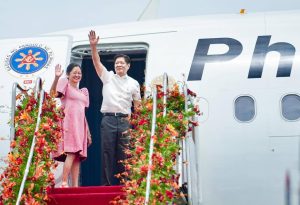Philippine President Ferdinand “Bongbong” Marcos Jr. ended his second State of the Nation address on Monday by declaring that the country’s situation is “sound and improving” as he heralds the rise of “Bagong Pilipinas” (New Philippines).
This was a reference to the new branding adopted by the Marcos government as part of its communications strategy.
“This administration commits to embody a brand of governance and leadership that is focused on implementing an all-inclusive plan for economic and social transformation,” according to an excerpt of the memorandum order issued by the president’s executive secretary.
The new branding “calls for deep and fundamental transformations in all sectors of society and government, and fosters the State’s commitment towards the attainment of comprehensive policy reforms and full economic recovery.”
It added that governance under Marcos will be “characterized by a principled, accountable and dependable government reinforced by unified institutions of society, whose common objective is to realize the goals and aspirations of every Filipino.”
The rebranding is mandatory for all government agencies which are now obligated to use the “Bagong Pilipinas” logo on official letterheads, websites, social media accounts, and state-funded flagship programs. The logo features the colors red, blue, white, and yellow which are also found in the country’s flag.
The announcement of the rebranding and the new logo was done after the decision to change the country’s tourism slogan and the changing of the logo of the Philippine Amusement and Gaming Corporation drew widespread criticism. This led some to accuse Marcos of being obsessed with token reforms instead of addressing the basic problems facing ordinary Filipinos.
Senator Jinggoy Estrada, a member of the majority bloc, insisted that the new government branding is not “superficial image-building” but a “guidepost or vision for a revitalized Philippines.” Senator Chiz Escudero, another member of the majority, is hopeful that the rebranding will “encourage government officials and employees not to be burdened by the frustrations and failures of the past to do a good and better job today.”
It is not unusual for a government to adopt new branding. Former President Benigno Aquino III used the theme “Daang Matuwid” (Straight Path) to underscore his government’s campaign against corruption. Former President Gloria Macapagal-Arroyo promoted the “Strong Republic” slogan as she pursued the strengthening of government institutions, while former President Fidel Ramos rallied the public to support “Philippines 2000” as part of his vision to turn the country into an economic powerhouse.
Marcos’ “Bagong Pilipinas” instantly stirred suspicions not just because of the recent flops in agency rebranding but all the more so because it resembles the “Bagong Lipunan” (New Society) slogan of the Martial Law regime of his father and namesake who ruled the country for two decades until his ouster through People Power in 1986.
House Deputy Leader Rep. France Castro is aghast that the president is keen on whitewashing the notorious legacy of his father.
“What essentially is happening now is that the current administration is trying to deodorize the infamous Marcos dictatorship using the resources of the Filipino people. We must not forget the human rights abuses, corruption, and repression that characterized the Marcos regime. Any attempt to glorify or revise this dark period in our history must be met with vigilance and opposition,” Castro said in a media interview.
Aside from using a similar government branding, the president has revived several programs of his father such as Masagana 99 to boost rural production, Kadiwa stores which offer cheaper goods in select areas, and even the decision to call the newly-launched sovereign wealth fund as Maharlika acknowledges the Marcos family’s fixation with the name. At one point, the president’s father proposed to rename the Philippines as Maharlika.
Opposition Senator Risa Hontiveros also noticed the similarity between “Bagong Pilipinas” and “Bagong Lipunan” which she said revived memories of corruption and human rights abuses. She advised the government to focus on delivering real reforms instead of being fixated on logo changes.
“No amount of branding can substitute for systems and institutions that truly level the playing field; no amount of branding can guarantee the end of economic inequality; no amount of branding can ensure that the wealth and progress of our country is felt by all, not only by a few,” she said in a statement.

































